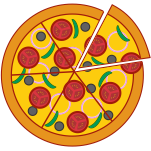What is Numerator?
When numbers are written in the form of a fraction, it can be represented as a⁄b , where a is the numerator and b is the denominator. For example, 4⁄5 is a fraction, and the line separating the numbers 4 and 5 is the fraction bar. Here the number above the fraction bar is the numerator, and the one below the fraction bar is the denominator. A numerator represents the number of parts out of the whole, which is the denominator.
Here is an example of a numerator:

Out of a pizza having 6 slices, Rena gets 1 slice. That means the fraction for Rena is 1⁄6 , where 1 is the numerator. In other words, she gets one-sixth of the pizza. Likewise, in 4⁄5 , 4 is the numerator; in the fraction 25⁄49 , 25 is the numerator and so on. So anything that is above the fraction bar or on the top in a fraction is the numerator.
Recommended Games
Misconceptions About Numerators:
It is always smaller than the denominator. The numerator is not necessarily smaller than the denominator. For example, 45⁄32 is a fraction, wherein 45 is the numerator, and is greater than the denominator. Such fractions are called improper fractions and are always greater than 1.
| Fun Facts About the Numerator – If the numerator is 0, then the entire fraction becomes zero, no matter what the denominator is! For example, 0⁄100 is 0; 0⁄2 is 0, and so on.The word “numerator” is derived from the Latin word numerātor, which means counter.If the numerator is the same as the denominator, the value of the fraction becomes 1. For example, if the fraction is 45⁄45 , then its value will be 1. |




































